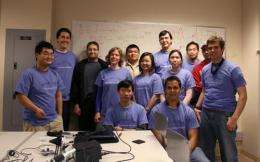Robotic Mouse Makes Maze Debut at UCSD (w/Video)

(PhysOrg.com) -- An intrepid group of UC San Diego undergraduate engineers designed and built a robotic mouse from scratch as part of the IEEE MicroMouse competition.
Test robotic mouse in maze.
Note any problems with robot behavior.
Tweak computer code.
Compile code.
Load new code on robotic mouse now tethered to laptop.
Unplug mouse and return it to maze.
Repeat.
Iterating through the to-do list above served as a recipe for extreme learning for an intrepid group of University of California, San Diego undergraduates who dared to design and build a robotic mouse from scratch. The electrical engineering and computer science undergraduates from the Jacobs School of Engineering also wrote the software to teach the robot to solve a maze. The team unveiled their mouse at the IEEE Region 6 Southwest Area Spring Meeting on Saturday, April 25th, held at UC San Diego.
The task the students faced was large, varied and complex. They had to build a robot to exact specifications and write the software necessary to enable the robot to figure out how to solve the maze. View the student’s poster here. The team also built the maze from scratch—a tribute to the width and breadth of their engineering expertise.
Alex Forencich, the team leader and an electrical engineering sophomore at the Jacobs School of Engineering, wrote much of the low level code that interacts with the robots’ hardware. Using Computer-aided design (CAD), Forencich also did much of the circuit board design. “We’ve got a processor board on top and a power supply board and a motor controller board,” said Forencich.
The robot—which is the size and shape of a cylindrical cookie jar—scoots around the maze thanks to a pair of wheels and two self lubricating sliders made from high-tech cutting board material.
The robot’s “vision” capabilities come from a set of distance sensors that shoot light at the maze walls. Based on the information that bounces back to the sensors, the robot can identify the openings in the maze walls. The sensor system also keeps the robot from bumping into walls.
This sensor-based approach “gives the robot vision without having to deal with the problems that a camera introduces,” said electrical engineering sophomore Jeffrey Wurzbach, who along with Forencich, was the driving force behind the project.
“The MicroMouse competition challenged the students to confront an entire robotics system, from the hardware and the low level code all the way to the high level code and all the related debugging tools. This is the kind of experience that potential employers and graduate school admissions committees are looking for,” said Charles Tu, Associate Dean of the Jacobs School of Engineering and a professor in the Department of Electrical and Computer Engineering. Tu is also the branch counselor for the IEEE UCSD Student Branch and the student activities coordinator for the IEEE San Diego Section.
“Overall, it has been a really good learning experience. We have learned to work as a team. We have learned to rely on each other,” said Shauna Thomas, a Jacobs School undergraduate studying electrical engineering and computer science.
Computer science major Vu Nguyen appreciated the opportunity to work with hardware.
Luan Pham, also a computer science major, enjoyed how the robot brought their code—written in C—to life.
While the MicroMouse project is usually considered to be a senior capstone design project, two key members of this year’s team—Alex Forencich, Jeffrey Wurzbach—are sophomores.
Amazing Maze
As if building a mobile problem-solving robot from scratch while carrying a full course load was not enough, the team of electrical engineering and computer science undergraduates spent five weeks building the 10 foot by 10 foot maze for the IEEE regional competition.
“According to IEEE people, we have the first and only student built maze in our region,” said Wurzbach, who led the maze-building project and offered his Del Mar driveway as a construction site. When the team realized the Wurzbach driveway was not flat enough to build a flat maze, they built a deck on top of the driveway, and then built the maze on top of the flat deck.
After building the maze, the students disassembled the deck and used the wood to build furniture for their lab space in the Jacobs School’s Engineering Building I (see sofa photo in blog post here). The collection of “deck furniture” includes a work bench and a sofa long enough for even the tallest member of the team-Alex Forencich, who is well over 6 feet tall-to nap on.
The IEEE Region 6 Southwest Area Spring Meeting also included a student paper competition. Jordan Rhee, a junior electrical engineering major from the Jacobs School won first place for his paper, “Hot Spot Mitigation in the StarCAVE”. Rhee is also the president of the IEEE UCSD Student Branch.
Provided by University of California - San Diego (news : web)




















